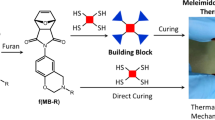Abstract
N-(4-Hydroxy phenyl)maleimide (HPMI) is functionalized with acryloyl, methacryloyl, allyl, propargyl and cyanate groups and the structures of the materials are characterized by FTIR, 1H NMR and 13C NMR. Thermal curing behaviours of the monomers and thermal stabilities of the polymers are studied using thermal analysis. Introduction of polymerizable groups shifts the curing exotherm to low temperatures, and the curing behaviour is dictated by the polymerizable substituent present in the aromatic ring. Polymer from acryloyl-functionalized monomer shows the highest thermal stability (402 °C), whereas the highest char value (49 % at 700 °C) is noted for the polymer obtained from propargyl-functionalized monomer. Polymers derived from functionalization of HPMI with acryloyl and methacryloyl showed better thermal stabilities. Thermosets formed by the thermal polymerization of HPMI functionalized with propargyl and cyanate groups showed higher char values at 700 °C in nitrogen atmosphere.








Similar content being viewed by others
References
Song YJ, Meng SH, Wang FD, Sun CX, Tan ZC. A study on the thermodynamic properties of polyimide BTDA-ODA by adiabatic calorimetry and thermal analysis. Therm Anal Calorim. 2002;69:617–25.
Feger CJ, Khojasteh MM, McGrath JE, editors. Polyimides: materials, chemistry and characterization. Amsterdam: Elsevier; 1989.
Totu E, Segal E, Covington AK. On the thermal behaviour of some polyimide membranes. Therm Anal Calorim. 1998;52:383–91.
Burcin G, Luminita C, Tarek A, Tsutomu T, Yusuf Y. Synthesis and characterization of maleimide (co)polymers with pendant benzoxazine groups by photoinduced radical polymerization and their thermal curing. J Polym Sci Part A. 2007;45:2774–86.
Howell BA, Zhang J. Thermal degradation of vinylidene chloride/vinyl chloride copolymers in the presence of N-substituted maleimides. Therm Anal Calorim. 2006;83:83–86.
Ali EA, Mokhtar SM, Elsabee MZ. The synthesis characterization and polymerization of novel thiophene substituted maleimide. Polym Plast Technol. 2010;49:953–62.
Elkholy SS. Chemical and radiation-induced grafting of p-carboxy n-phenyl maleimide onto chitosan. Polym Plast Technol. 2010;47:299–306.
Cassidy PE, editor. Thermally stable polymers. New York: Marcel Dekker; 1980.
Wilson D, Stenzenberger HD, Hergenrother PM, editors. Polyimides: chemistry and applications. London: Blackie, Glasgow; 1990.
Vijayakumar CT, Periyadurai T, Alam S. Synthesis and polymerisation of ismaleimide derived from 5(6)-amino-1(4′-aminophenyl)-1,3,3′-trimethyl indane. Polym Plast Technol. 2009;48:141–51.
Yu-Sheng T, Jie Kong J, Gu J, Liang G. Reinforced cyanate ester resins with carbon nanotubes: surface modification, reaction activity and mechanical properties analyses. Polym Plast Technol. 2009;48:359–66.
Kirchhoff RA. US Patent, 4540743; 1985.
Wang PC. Thermosetting resin compositions. US Patent 4921931;1990.
Kovar RF, Ehlers GFL, Arnold FE. Thermosetting acetylene-terminated polyphenylquinoxalines. J Polym Sci Polym Chem. 1977;15:1081–95.
Walton TR. US Patent, 4336362; 1982.
Lucotte G, Cormier L, Delfort B. Ethynyl terminated ethers. Synthesis and thermal characterization of 2,2 bis(ethynyl-4-phenylcarbonyl-4-phenoxy-4-phenyl) propane and 2,2 bis(ethynyl-4-phenylsulfonyl-4-phenoxy-4-phenyl) propane. Polym Bull. 1990;24:577.
Vijayakumar CT, Lederer K, Kramer A. The ene reaction between N-isobutylallylnadimide and N-isobutylmaleimide as a model for the cross-linking reaction in bis(allyl)nadimide polymerization. Die Makromol Chem. 1990;191:2579–85.
B. Gaur B, Lochab B, Choudhary V, Varma IK. Thermal behaviour of poly(allyl azide). Therm Anal Calorim. 2003;71:467–79.
Cho HN, Lee JY, Kim SH, Choi SK, Kim CY. Synthesis and properties of poly(dipropargyl-16-crown-5). Polym Bull. 1996;36:391–8.
Gilman JW, Otonari YA, Chapman RD. Synthesis of new triisocyanate curatives 2,2-bis(isocyanatomethyl)propyl isocyanate and 4-(isocyanatomethyl)-1,7-heptyl diisocyanate. Polym Bull. 1992;27:591–7.
Dirlikov SK. Propargyl-terminated resins: a hydrophobic substitute for epoxy resins. High Perform Polym. 1990;2:67–77.
Reghunadhan NCP. Advances in addition-cure phenolic resins. Prog Polym Sci. 2004;29:401–98.
Zahir SA, Renner A. Chem Abstr. U.S. 4, 100, 140; 1978.
Vijayakumar CT, Lederer K, Kramer A. Structural aspects of polyimides. I. Polymerization and degradation of endo-N-phenylnadimide and endo-N-isobutylnadimide. J Polym Sci Part A. 1989;27:2723.
Mijovic J, Andjelic S. Study of the mechanism and rate of bismaleimide cure by remote in-situ real time fiber optic near-infrared spectroscopy. Macromolecules. 1996;29:239–46.
Rakesh S, Sarojadevi M. Synthesis and characterization of cyanate ester and its blends with bisphenol dicyanate ester. Chem Chem Technol. 2008;2:239–45.
Jayakumari LS, Sampath PS, Sarojadevi M. Synthesis and characterization of cyanate ester and its blends with bisphenol dicyanate ester. J Appl Polym Sci. 2009;. doi:10.1002/app.29882.
Grenier-Loustalot MF, Sanglar C. Prepolymers with propargylic terminal residues-I. simulation of reaction mechanisms and kinetics on monofunctional models. Eur Polym J. 1997;33:1125–34.
Koz B, Kiskan B. Novel benzoxazine monomer with methacrylate functionality and its thermally curable (co)polymers. Yu A Polym Bull. 2012;66:165–74.
Reghunadhan Nair CP, Krishnan K, Ninan KN. Differential scanning calorimetric study on the Claisen rearrangement and thermal polymerisation of diallyl ether of bisphenols. Thermochim Acta. 2000;359:61–7.
Kolb GC, Scheck DM, Dirlikov SK. Polymer resulting from the cure of a preformed chromene containing mixture. Patent 5155196, USA; 1992.
Douglas WE, Overend AS. Curing reactions in acetylene terminated resions-I. Uncatalyzed cure of arylpropargylether terminated monomers. Eur Polym J. 1991;27:1279–87.
Stenzenberger HD. Addition polyimides. Adv Polym Sci. 1994;117:165.
Hsien Lin R, Hua Lin W, Wei LinC. Cure reactions in the blend of cyanate ester with maleimide. Polymer. 2004;45:4423–35.
Samikannu Rakesh S, Sarojadevi M. Synthesis and characterisation of cyante esrter and its blends with bisphenol dicyanete ester. Chem Chem Technol. 2008;2:4.
Caykaraa T, Ozyureka C, Kantoglub O, Erdogana B. Thermal behavior of poly(2-hydroxyethyl methacrylate-maleic acid) networks. Polym Degrad Stabil. 2003;80:339–43.
Shantilal L, Natish S, Vijay K, Harish B, Chetan B. Synthesis, characterization and thermal properties of co-poly(maleimide-methylmethacrylate), terpoly(maleimide-methylmethacrylate-acrylic acid), and terpoly(maleimide-methylmethacrylatemethylacrylic acid) Iran. Polym J. 2004;13:297–305.
Acknowledgments
The authors would like to thank the Board of Research in Nuclear Science (BRNS), Department of Atomic Energy (DAE), Government of India, BARC, Mumbai-400 085 for financially supporting this study under the Grant 2010/35/5/BRNS/1279 dated 11-08-2010. The authors wish to thank Lalit Varshney and K. S. S. Sharma of BARC for their constant encouragement and support. The authors also owe their sincere thanks to the Management and the Principal of Kamaraj College of Engineering and Technology, S.P.G.C. Nagar, K. Vellakulam Post-625701, India for providing all the facilities to complete this study.
Author information
Authors and Affiliations
Corresponding author
Rights and permissions
About this article
Cite this article
Pitchaimari, G., Vijayakumar, C.T. Functionalized monomers based on N-(4-hydroxy phenyl)maleimide. J Therm Anal Calorim 114, 1351–1361 (2013). https://doi.org/10.1007/s10973-013-3174-4
Received:
Accepted:
Published:
Issue Date:
DOI: https://doi.org/10.1007/s10973-013-3174-4




